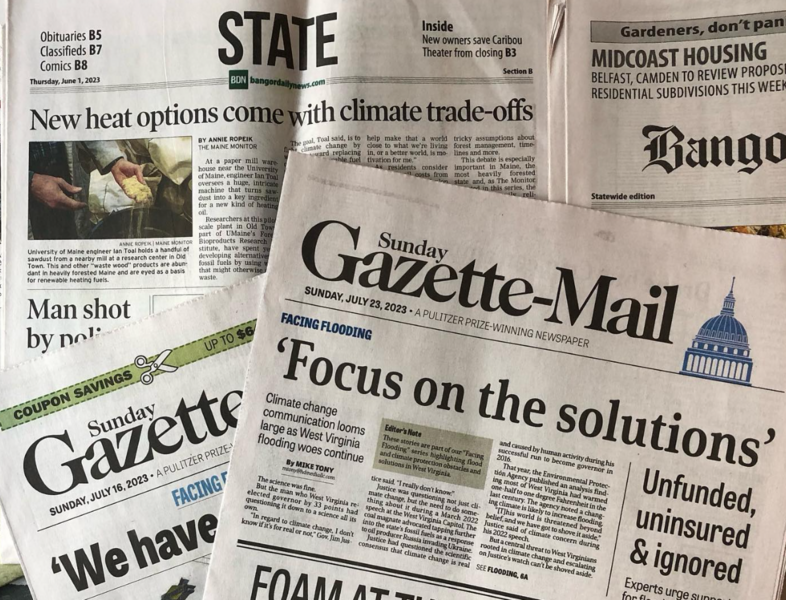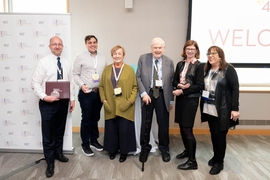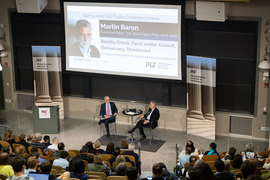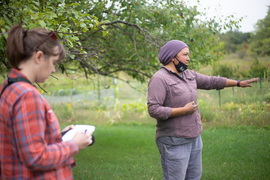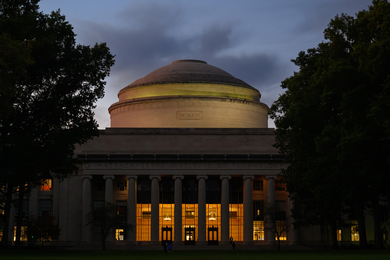Last year, Pew Research Center data revealed that only 37 percent of Americans said addressing climate change should be a top priority for the president and Congress. Furthermore, climate change was ranked 17th out of 21 national issues included in a Pew survey.
But in reality, it’s not that Americans don’t care about climate change, says celebrated climate scientist and communicator Katharine Hayhoe. It’s that they don’t know that they already do.
To get Americans to care about climate change, she adds, it’s imperative to guide them to their gate. At first, it might not be clear where that gate is. But it exists.
That message was threaded through the Connecting with Americans on Climate Change webinar last fall, which featured a discussion with Hayhoe and the five journalists who made up the 2023 cohort of the MIT Environmental Solutions Journalism Fellowship. Hayhoe referred to a “gate” as a conversational entry point about climate impacts and solutions. The catch? It doesn’t have to be climate-specific. Instead, it can focus on the things that people already hold close to their heart.
“If you show people … whether it’s a military veteran or a parent or a fiscal conservative or somebody who is in a rural farming area or somebody who loves kayaking or birds or who just loves their kids … how they’re the perfect person to care [about climate change], then it actually enhances their identity to advocate for and adopt climate solutions,” said Hayhoe. “It makes them a better parent, a more frugal fiscal conservative, somebody who’s more invested in the security of their country. It actually enhances who they already are instead of trying to turn them into someone else.”
The MIT Environmental Solutions Journalism Fellowship provides financial and technical support to journalists dedicated to connecting local stories to broader climate contexts, especially in parts of the country where climate change is disputed or underreported.
Climate journalism is typically limited to larger national news outlets that have the resources to employ dedicated climate reporters. And since many local papers are already struggling — with the country on track to lose a third of its papers by the end of next year, leaving over 50 percent of counties in the United States with just one or no local news outlets — local climate beats can be neglected. This makes the work executed by the ESI’s fellows all the more imperative. Because for many Americans, the relevance of these stories to their own community is their gate to climate action.
“This is the only climate journalism fellowship that focuses exclusively on local storytelling,” says Laur Hesse Fisher, program director at MIT ESI and founder of the fellowship. “It’s a model for engaging some of the hardest audiences to reach: people who don’t think they care much about climate change. These talented journalists tell powerful, impactful stories that resonate directly with these audiences.”
From March to June, the second cohort of ESI Journalism Fellows pursued local, high-impact climate reporting in Montana, Arizona, Maine, West Virginia, and Kentucky.
Collectively, their 26 stories had over 70,000 direct visits on their host outlets’ websites as of August 2023, gaining hundreds of responses from local voters, lawmakers, and citizen groups. Even though they targeted local audiences, they also had national appeal, as they were republished by 46 outlets — including Vox, Grist, WNYC, WBUR, the NPR homepage, and three separate stories on NPR’s “Here & Now” program, which is broadcast by 45 additional partner radio stations across the country — with a collective reach in the hundreds of thousands.
Micah Drew published an eight-part series in The Flathead Beacon titled, “Montana’s Climate Change Lawsuit.” It followed a landmark case of 16 young people in Montana suing the state for violating their right to a “clean and healthful environment.” Of the plaintiffs, Drew said, “They were able to articulate very clearly what they’ve seen, what they’ve lived through in a pretty short amount of life. Some of them talked about wildfires — which we have a lot of here in Montana — and [how] wildfire smoke has canceled soccer games at the high school level. It cancels cross-country practice; it cancels sporting events. I mean, that’s a whole section of your livelihood when you’re that young that’s now being affected.”
Joan Meiners is a climate news reporter for the Arizona Republic. Her five-part series was situated at the intersection of Phoenix’s extreme heat and housing crises. “I found that we are building three times more sprawling, single-family detached homes … as the number of apartment building units,” she says. “And with an affordability crisis, with a climate crisis, we really need to rethink that. The good news, which I also found through research for this series … is that Arizona doesn’t have a statewide building code, so each municipality decides on what they’re going to require builders to follow … and there’s a lot that different municipalities can do just by showing up to their city council meetings [and] revising the building codes.”
For The Maine Monitor, freelance journalist Annie Ropeik generated a four-part series, called “Hooked on Heating Oil,” on how Maine came to rely on oil for home heating more than any other state. When asked about solutions, Ropeik says, “Access to fossil fuel alternatives was really the central equity issue that I was looking at in my project, beyond just, ‘Maine is really relying on heating oil, that obviously has climate impacts, it’s really expensive.’ What does that mean for people in different financial situations, and what does that access to solutions look like for those different communities? What are the barriers there and how can we address those?”
Energy and environment reporter Mike Tony created a four-part series in The Charleston Gazette-Mail on West Virginia’s flood vulnerabilities and the state’s lack of climate action. On connecting with audiences, Tony says, “The idea was to pick a topic like flooding that really affects the whole state, and from there, use that as a sort of an inroad to collect perspectives from West Virginians on how it’s affecting them. And then use that as a springboard to scrutinizing the climate politics that are precluding more aggressive action.”
Finally, Ryan Van Velzer, Louisville Public Media’s energy and environment reporter, covered the decline of Kentucky’s fossil fuel industry and offered solutions for a sustainable future in a four-part series titled, “Coal’s Dying Light.” For him, it was “really difficult to convince people that climate change is real when the economy is fundamentally intertwined with fossil fuels. To a lot of these people, climate change, and the changes necessary to mitigate climate change, can cause real and perceived economic harm to these communities.”
With these projects in mind, someone’s gate to caring about climate change is probably nearby — in their own home, community, or greater region.
It’s likely closer than they think.
To learn more about the next fellowship cohort — which will support projects that report on climate solutions being implemented locally and how they reduce emissions while simultaneously solving pertinent local issues — sign up for the MIT Environmental Solutions Initiative newsletter. Questions about the fellowship can be directed to Laur Hesse Fisher at climate@mit.edu.
